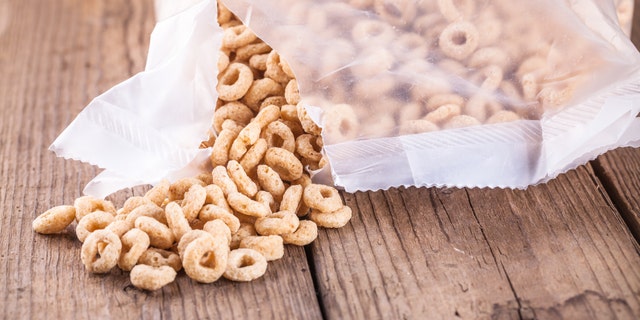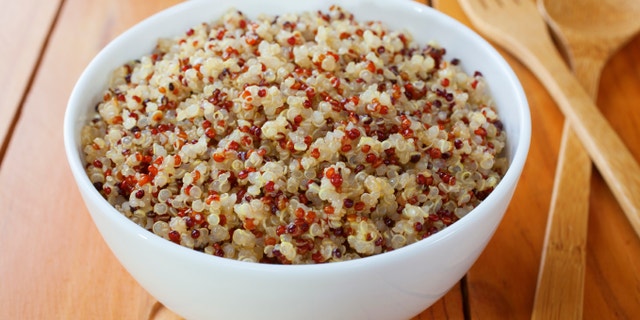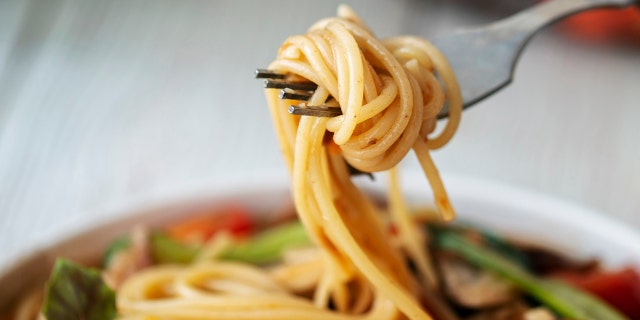Managing cholesterol is an essential part of maintaining overall health, especially for those who struggle with keeping their numbers in the right place.
Boston-based registered dietitian-nutritionist Nikita Kapur told Fox News Digital that high cholesterol can lead to cardio-metabolic risk factors such as heart disease, diabetes and atherosclerosis (a buildup of plaque in and on the artery walls).
Heightened LDL levels, also known as “bad cholesterol,” can put the body at risk for these complications, which is often genetic but can also be manipulated by diet and lifestyle factors.
HOW SMALL CHANGES IN YOUR DIET CAN RESULT IN REALLY BIG HEALTH PAYOFFS
“Sometimes we see very stubborn levels of high cholesterol that don’t necessarily respond favorably to diet and lifestyle,” she said in an interview.
“But there are always benefits to focusing on those lifestyle factors.”

A woman indulges in a plate of nuts and seeds. "The goal is to improve soluble fiber, which a lot of us don’t get these days."
(iStock)
Kapur, lead dietician at Compass Nutrition, explained that a mindful diet in terms of managing cholesterol first involves incorporating food sources rich in soluble fibers.
These are present in plant foods such as legume beans, nuts, seeds, fruits, vegetables and whole grains.
“The goal is to improve soluble fiber, which a lot of us don’t get these days,” she said. “And the recommendations tend to be anywhere from 25 to 30 grams.”
EAT THESE 5 POWER FOODS TO HELP PREVENT CANCER
Omega-3s and healthy fats found in fish, seeds and oils are also good for lowering cholesterol.
If this seems like a lot to chew on — here are five quick diet swaps to help manage cholesterol levels.
1. Swap sugary cereal for a high-fiber alternative
Instead of reaching for a bowl of Reese’s Puffs, try cereal alternatives that are higher in fiber and lower in sugar.

"Plain, old-school Cheerios we know have a very high concentrations of oats," said registered dietitian-nutritionist Nikita Kapur of Boston.
(iStock)
Kapur encouraged consumers to focus on fiber content and the “quality of carbohydrates” instead of calories.
“Plain, old-school Cheerios we know have very high concentrations of oats,” she said.
“And then oats have a lot of beta-glucan and fiber that can be beneficial for reducing cholesterol.”
SLOW-ROASTED TOMATOES: SWEET, HEALTHY RECIPE FOR FAMILIES WHO LOVE FRESH FOOD
Oatmeal can be another great swap for cereal, as well as high-fiber, sprouted-oats bread.
2. Replace white rice with brown rice
Achieving a cholesterol-conscious diet includes a consistent focus on whole grains.
White rice eaters should try switching to brown rice or other alternatives with a little more nutritional value like farro, barley or quinoa, she suggested.

A bowl of cooked red, white and black quinoa and amaranth is shared at a table. White rice eaters can try switching to foods like this that offer better nutritional value.
(iStock)
The whole grain, high-fiber swap can also be done by switching out flour tortillas for corn tortillas or simply leaving the skins on potatoes, which adds more fiber.
POTATO HARVESTING: HOW TO KNOW WHEN TO UNEARTH YOUR HOMEGROWN SPUDS
Today, she said, “we have a lot of high-fiber packaged products as well, like pastas or breads.”
It’s important to build a diet that ensures “food is still satisfying” while also not breaking the bank, Kapur added.
“Bean-based pastas and whole grain-based pastas do have more protein,” she said.

Spaghetti is swirled onto a fork. Try whole-grain pasta choices as part of a heathy diet.
(iStock)
“But we want sustainable behaviors — so if that’s something you have to force yourself to eat, there are other ways to get those benefits.”
3. Sub in one plant-based meal
Plant-forward eating is a recent trend, which is a plus for people looking to clean up their diet.
FRUIT OR VEGETABLE? TAKE THIS QUIZ TO TEST YOUR HEALTHY FOOD KNOWLEDGE
Although some new plant-based food products can be synthetic and heavily processed, Kapur suggested consumers focus on “humble” plant products made of beans, tofu and edamame.

Beans are an excellent source of slow-release carbohydrates, as well as a good source of protein and fiber, which slow the digestive process to help us stay fuller for a longer time.
(iStock)
Kapur recommended subbing in one plant-based meal per day to help lower cholesterol.
“If you’re someone who is doing eggs for breakfast, chicken for lunch and turkey for dinner, that would be a good place to swap and add black beans instead of turkey [for] one meal,” she said.
“You still get to eat your animal proteins, but you’re making room for those plant nutrients.”
4. Try seeds if fish isn’t your thing
While a variety of fish are high in omega-3s — a great resource for keeping bad cholesterol at bay — not everyone is a fish fan.
CLICK HERE TO SIGN UP FOR OUR LIFESTYLE NEWSLETTER
Kapur suggested swapping fish for various nuts and seeds such as flax, chia, hemp, sesame, sunflower and pumpkin seeds, as well as almonds and walnuts.

A variety of healthy and organic nuts and seeds are shown here. Try swapping fish for various nuts and seeds such as flax, chia, hemp, sesame, sunflower and pumpkin seeds, as well as almonds and walnuts, said Kapur.
(iStock)
“They will try to mimic some of that omega-3 profile,” she said.
For those who eat fish but can’t spend a fortune, Kapur suggested trying smaller fish such as sardines and mackerel, which are more affordable and available at most food stores.
5. Switch regular peanut butter for unsalted, no-sugar-added nut butter
Peanut butter can sometimes get a bad rap in diet discussions, but Kapur said there’s no need to ditch it.

Peanut butter spread across a piece of bread. It’s wise to swap any kind of nut butter — peanut, almond, sunflower and others — for unsalted and no-sugar-added nut butter, said one nutrition expert.
(iStock)
The better option is to swap any kind of nut butter — peanut, almond, sunflower and others — for unsalted and no-sugar–added nut butter.
Maintaining a balanced diet is key, Kapur emphasized — and too much of anything isn’t beneficial to our overall health.
“An easier way to organically focus on making sure that quantity is not an issue is by eating a wide variety of foods, making sure that you are eating consistently and balancing your meals.”
CLICK HERE TO GET THE FOX NEWS APP
“They all matter,” she said.
“We don’t want to be fearing the fats we get from nuts and seeds and olives and avocados.”
 Iktodaypk Latest international news, sport and comment
Iktodaypk Latest international news, sport and comment




